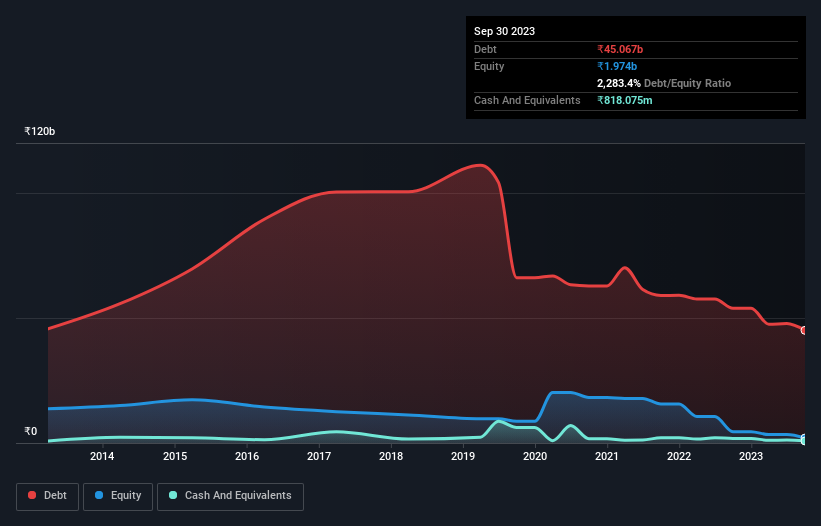Warren Buffett famously said, 'Volatility is far from synonymous with risk.' So it might be obvious that you need to consider debt, when you think about how risky any given stock is, because too much debt can sink a company. Importantly, Sadbhav Engineering Limited (NSE:SADBHAV) does carry debt. But is this debt a concern to shareholders?
What Risk Does Debt Bring?
Generally speaking, debt only becomes a real problem when a company can't easily pay it off, either by raising capital or with its own cash flow. Part and parcel of capitalism is the process of 'creative destruction' where failed businesses are mercilessly liquidated by their bankers. However, a more frequent (but still costly) occurrence is where a company must issue shares at bargain-basement prices, permanently diluting shareholders, just to shore up its balance sheet. Of course, debt can be an important tool in businesses, particularly capital heavy businesses. When we examine debt levels, we first consider both cash and debt levels, together.
See our latest analysis for Sadbhav Engineering
What Is Sadbhav Engineering's Net Debt?
You can click the graphic below for the historical numbers, but it shows that Sadbhav Engineering had ₹45.1b of debt in September 2023, down from ₹53.9b, one year before. And it doesn't have much cash, so its net debt is about the same.

A Look At Sadbhav Engineering's Liabilities
According to the last reported balance sheet, Sadbhav Engineering had liabilities of ₹70.7b due within 12 months, and liabilities of ₹12.1b due beyond 12 months. On the other hand, it had cash of ₹818.1m and ₹8.28b worth of receivables due within a year. So it has liabilities totalling ₹73.7b more than its cash and near-term receivables, combined.
This deficit casts a shadow over the ₹3.20b company, like a colossus towering over mere mortals. So we definitely think shareholders need to watch this one closely. After all, Sadbhav Engineering would likely require a major re-capitalisation if it had to pay its creditors today. When analysing debt levels, the balance sheet is the obvious place to start. But ultimately the future profitability of the business will decide if Sadbhav Engineering can strengthen its balance sheet over time. So if you want to see what the professionals think, you might find this free report on analyst profit forecasts to be interesting.
Over 12 months, Sadbhav Engineering made a loss at the EBIT level, and saw its revenue drop to ₹19b, which is a fall of 6.9%. We would much prefer see growth.
Caveat Emptor
Over the last twelve months Sadbhav Engineering produced an earnings before interest and tax (EBIT) loss. Its EBIT loss was a whopping ₹1.1b. When you combine this with the very significant balance sheet liabilities mentioned above, we are so wary of it that we are basically at a loss for the right words. Sure, the company might have a nice story about how they are going on to a brighter future. But the reality is that it is low on liquid assets relative to liabilities, and it lost ₹3.8b in the last year. So we think buying this stock is risky. The balance sheet is clearly the area to focus on when you are analysing debt. But ultimately, every company can contain risks that exist outside of the balance sheet. For example Sadbhav Engineering has 2 warning signs (and 1 which can't be ignored) we think you should know about.
Of course, if you're the type of investor who prefers buying stocks without the burden of debt, then don't hesitate to discover our exclusive list of net cash growth stocks, today.
New: Manage All Your Stock Portfolios in One Place
We've created the ultimate portfolio companion for stock investors, and it's free.
• Connect an unlimited number of Portfolios and see your total in one currency
• Be alerted to new Warning Signs or Risks via email or mobile
• Track the Fair Value of your stocks
Have feedback on this article? Concerned about the content? Get in touch with us directly. Alternatively, email editorial-team (at) simplywallst.com.
This article by Simply Wall St is general in nature. We provide commentary based on historical data and analyst forecasts only using an unbiased methodology and our articles are not intended to be financial advice. It does not constitute a recommendation to buy or sell any stock, and does not take account of your objectives, or your financial situation. We aim to bring you long-term focused analysis driven by fundamental data. Note that our analysis may not factor in the latest price-sensitive company announcements or qualitative material. Simply Wall St has no position in any stocks mentioned.
About NSEI:SADBHAV
Sadbhav Engineering
Engages in engineering, construction, and infrastructure development projects business in India.
Good value with slight risk.
Similar Companies
Market Insights
Community Narratives



